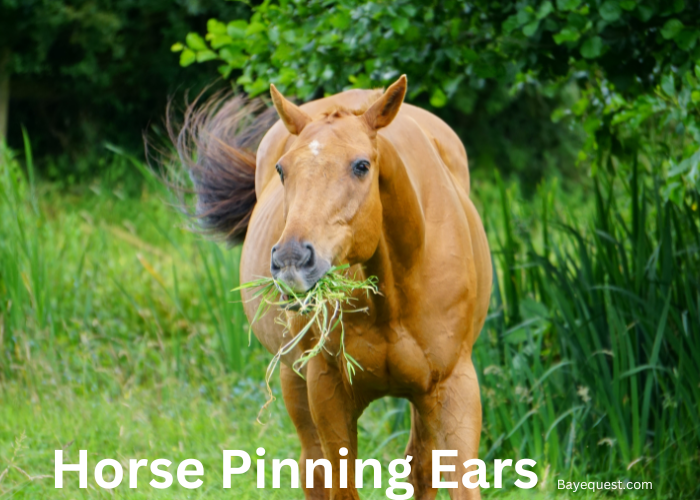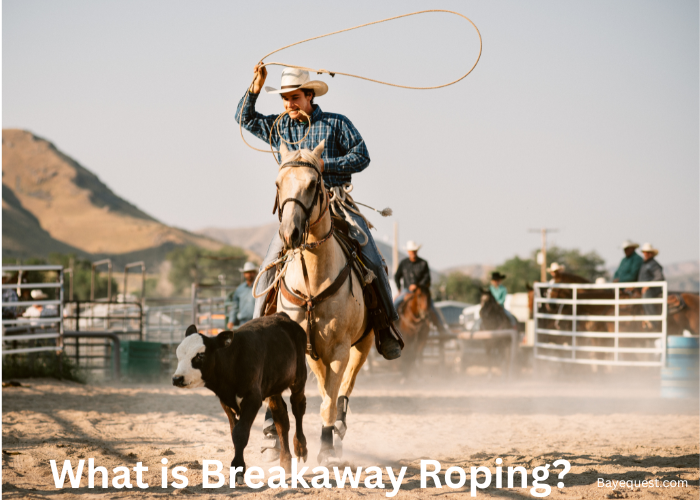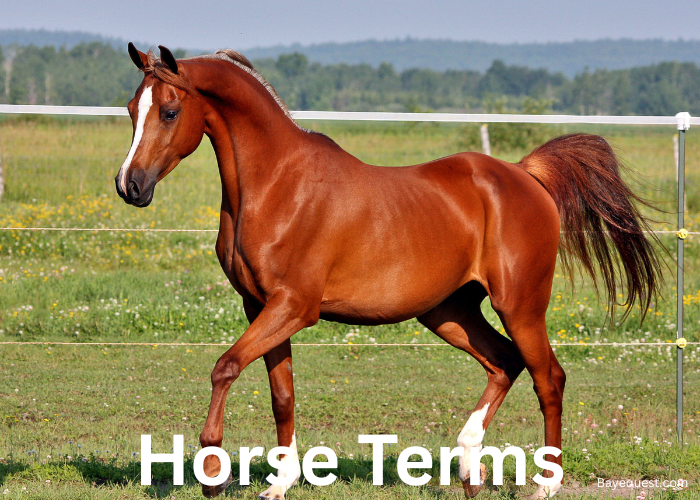A horse’s ears say a lot. More than you might think. When they pin them flat against their head, it’s not just for fun. It’s a message.
But what exactly are they trying to tell you? Annoyance? Pain? A warning to back off?
Horses use ear pinning to communicate, and understanding it can make a big difference in how you handle them.
Sometimes, it’s harmless; other times, it’s a red flag. Either way, knowing the why behind this behavior helps you respond the right way.
Let’s break it down. No guessing, no misunderstandings, just clear, simple answers.
Horse Pinning Ears: Key Takeaway
Horses pin their ears to communicate. It can mean annoyance, pain, or dominance. Some horses also pin their ears when focused or playing. To understand why, watch their body language. Signs like bared teeth or tense muscles mean aggression, while relaxed posture suggests concentration. Context helps determine the right response.
What is Ear Pinning in Horses?
Ear pinning in horses happens when a horse flattens its ears backward against its head.
It’s one of the clearest signals in equine body language and usually means the horse is feeling irritated, defensive, or aggressive.
However, not all ear pinning is negative. Some horses do it when they’re focused or concentrating.
Horses communicate through their ears, using different positions to show emotions.
Pinned ears, especially when combined with other body language cues, can signal anything from mild annoyance to a serious warning.
Understanding when and why a horse pins its ears helps you respond appropriately and prevent conflicts.
What Does It Mean When a Horse Pins Its Ears?
When a horse pins its ears, it’s sending a clear message. But the meaning depends on the situation.
Most of the time, pinned ears signal annoyance, discomfort, or aggression. It’s a warning “Back off” or “I don’t like this.”
However, not all ear pinning is negative. Some horses pin their ears when they’re focused, like during training or play.
Others may do it briefly in social interactions to establish dominance.
To understand the true meaning, look at the horse’s body language.
A tense posture, bared teeth, or swishing tail? Likely aggression. A relaxed body and pinned ears while working? Just concentration.
Common Reasons Horses Pin Their Ears
Horses pin their ears for many reasons, and not all of them are bad. Here are the most common causes:
1. Aggression or warning
A horse may pin its ears to tell another horse, or a human, to back off. This is often seen in herd dynamics, feeding time, or when a horse feels threatened.
2. Irritation or discomfort
Pain from an ill-fitting saddle, dental issues, or an underlying health problem may cause pinning of ears.
Reaction to annoying stimuli like flies, loud noises, or rough handling may also be a reason.
3. Concentration and focus
Some horses pin their ears when they’re deeply focused on a task. This is often seen in training, jumping, or intense work.
4. Food aggression (Resource guarding)
A horse may pin its ears to warn others to stay away from its feed. This is more common in competitive feeding situations.
5. Social interactions and herd behavior
Horses use ear pinning to establish dominance within a herd. Sometimes, it’s just a quick warning to set boundaries with other horses.
6. Frustration or confusion in training
A horse that doesn’t understand what’s being asked may pin its ears in frustration. Harsh training methods or conflicting cues can also trigger this response.
7. Playfulness or excitement
Some horses pin their ears while playing, especially during roughhousing. Look at the rest of their body language. Loose and relaxed means it’s just fun.
How to Interpret a Horse’s Body Language When It Pins Its Ears
A horse’s ears don’t work alone. They’re just one piece of a bigger puzzle.
To truly understand what a horse is feeling, you need to observe the rest of its body language.
Let’s learn how to interpret a horse’s body language when it pins its ears.
Facial expressions matter
A horse’s face reveals a lot about its mood. If the lips are tight and the nostrils are flared, the horse is likely tense or stressed.
Bared teeth, especially when combined with pinned ears, are a clear sign of aggression or a warning to stay away.
On the other hand, if the muzzle is soft and relaxed, the horse may simply be concentrating on a task.
Checking a horse’s facial tension helps differentiate between harmless ear pinning and a real issue.
The eyes show emotion
A horse’s eyes can give away its emotions just as much as its ears.
Wide eyes with visible whites usually indicate fear or stress, especially if paired with a stiff body.
If the horse’s eyes are soft and calm, even with pinned ears, it might just be paying attention to something or feeling mildly annoyed.
Blinking and relaxed eyelids are good signs that the horse isn’t truly upset.
Posture tells the full story
A horse’s stance can reveal whether ear pinning is a minor reaction or a serious threat.
If a horse is standing stiffly with its muscles tight, it may be feeling defensive or preparing to act aggressively.
A raised head and braced legs usually mean the horse is on high alert.
However, if the horse has a loose, relaxed posture and only momentarily pins its ears, it might just be setting a boundary or showing mild irritation.
Watch the tail and movement
A swishing or lashing tail often signals irritation, especially if it happens alongside pinned ears.
If the horse’s tail is clamped tightly against its body, it may be feeling anxious or uncomfortable.
Additionally, sudden movements like stomping, backing up, or shifting weight can indicate frustration or preparation to kick.
These signs, when combined with pinned ears, suggest a stronger emotional response that needs attention.
Putting it all together
To interpret ear pinning correctly, you must consider the entire picture.
A horse standing calmly with pinned ears might just be concentrating, but if it’s stiff, swishing its tail, or showing the whites of its eyes, it could be feeling threatened or aggressive.
How to Respond When a Horse Pins its Ears
When a horse pins its ears, your reaction matters. Overreacting can make things worse while ignoring it could put you in danger.
The key is understanding why the horse is pinning its ears and responding appropriately.
Here’s how to handle different situations effectively.
Stay calm and observe
The first step is to stay calm. Horses pick up on human emotions, so reacting with fear or anger can escalate the situation.
Instead of immediately correcting the behavior, take a moment to assess what’s happening.
Is the horse in pain? Feeling threatened? Just mildly annoyed? Identifying the trigger will help you respond correctly.
Check for pain or discomfort
Horses often pin their ears due to physical discomfort. If the behavior happens during riding, check for an ill-fitting saddle, bridle, or bit.
A horse that pins its ears when touched in a certain area may have a sore spot or underlying health issue.
Look for other signs of pain, such as stiffness, flinching, or resistance. If you suspect discomfort, consult a vet or equine chiropractor.
Assess the social dynamic
If a horse pins its ears at another horse, it’s usually about dominance or establishing boundaries. In a herd setting, this is normal behavior.
However, if a horse is being overly aggressive and causing injuries, you may need to separate them or adjust herd arrangements.
Avoid immediate punishment
It’s tempting to correct a horse the moment it pins its ears, but punishment isn’t always the right approach.
If the behavior stems from fear, pain, or confusion, harsh discipline can create more stress. Instead, focus on addressing the root cause.
If the horse is testing boundaries or showing dominance, a firm but fair correction, such as asking for space or redirecting attention, may be necessary.
Modify training methods
If a horse frequently pins its ears during training, it could be frustrated or confused. Review your training methods to ensure cues are clear and fair.
If the horse responds negatively to a specific movement or request, break it down into smaller steps and use positive reinforcement.
Avoid harsh corrections, as they can make the horse more defensive.
Address food aggression
Some horses pin their ears to guard their food. If this happens, avoid hand-feeding or crowding the horse at mealtime.
Feeding in separate spaces can reduce competition and stress.
If the behavior escalates into aggression, consistent groundwork and desensitization exercises can help teach the horse that humans aren’t a threat to its food.
Recognize play vs serious aggression
Not all ear pinning is dangerous. Some horses pin their ears while playing, especially during roughhousing.
If the horse is otherwise relaxed and engaged, there’s no need to interfere.
However, if the pinned ears come with bared teeth, charging, or kicking, it’s time to step in and establish boundaries.
When to seek professional help
If a horse consistently pins its ears aggressively, despite good training and care, it may need professional evaluation.
A trainer or equine behaviorist can help identify deep-rooted issues and develop a plan to correct them.
Persistent ear pinning combined with behavioral changes may also warrant a veterinary checkup to rule out health problems.
When to Be Concerned About Ear Pinning
Ear pinning isn’t always a problem, but sometimes it signals something serious. Here’s when ear pinning should raise a red flag.
1. When it’s persistent or unprovoked
If a horse constantly pins its ears, even when there’s no clear reason, it could indicate discomfort, stress, or an underlying behavioral issue.
Occasional ear pinning is normal, but if it happens frequently in various situations, it’s worth investigating.
2. When it’s combined with aggression
Horses use ear pinning as a warning before escalating to more aggressive actions like biting, kicking, or charging.
If a horse frequently pins its ears at humans or other horses in a threatening way, it may be testing dominance or reacting out of fear.
This can become dangerous, especially if the aggression escalates.
3. When it happens during riding or handling
If a horse pins its ears while being ridden, saddled, or groomed, it might be trying to tell you something hurts.
A poorly fitting saddle, a tight girth, or even a sore back can cause discomfort. If the behavior continues despite proper training and handling, checking for pain is essential.
4. When it’s accompanied by other signs of pain
Ear pinning alone doesn’t always indicate pain, but when combined with other symptoms, it can be a warning sign. Look for:
- Flinching or reacting negatively to touch
- Reluctance to move forward under saddle
- Grinding teeth or excessive tail swishing
- Weight shifting or stiffness
If these signs are present, get a vet check. Conditions like ulcers, dental problems, or joint pain could be causing discomfort.
5. When it signals anxiety or fear
A horse that pins its ears in stressful environments, such as during transport, at competitions, or in a new setting, may be experiencing anxiety.
Fear based ear pinning is often paired with a tense body, wide eyes, and a raised head.
If a horse shows these signs often, desensitization training and a confidence-building approach may help.
6. When it happens around food consistently
Mild food aggression is common, but if a horse becomes overly defensive at feeding time, pinning ears, lunging, or kicking, it can lead to dangerous situations.
This behavior should be addressed through feeding management strategies, like providing separate feeding areas or using training techniques to discourage guarding behavior.
7. When it becomes a habit
Sometimes, horses develop negative habits from past experiences.
If a horse has learned that ear pinning gets it what it wants (such as scaring others away), the behavior may become ingrained.
In these cases, consistent training and boundary setting are necessary to correct the habit.
How to Prevent Negative Ear Pinning in Horses
Ear pinning is a natural way for horses to communicate, but when it becomes frequent, aggressive, or a sign of discomfort, it needs to be addressed.
Here’s how to reduce unwanted ear pinning in horses.
1. Ensure proper tack fit
Poorly fitting saddles, bits, or bridles can cause discomfort and lead to ear pinning. Regularly check and adjust tack for a proper fit.
2. Rule out pain or health issues
Horses in pain often pin their ears. Common causes include ulcers, joint pain, or dental issues.
Regular vet checkups help prevent discomfort-related behaviors.
3. Train with clear, fair methods
Confusion and frustration can cause ear pinning. Use consistent, positive training methods and avoid harsh corrections.
4. Address food aggression
Horses may pin ears to guard food. Feed them separately, provide enough space, and train them to relax during mealtime.
5. Monitor herd dynamics
Ear pinning is normal in herd settings but excessive aggression may need intervention. Ensure enough space and separate dominant horses if needed.
6. Reduce stress and boredom
Horses need mental and physical stimulation. Provide daily turnout, training variety, and enrichment toys to prevent frustration.
7. Respect personal boundaries
Some horses dislike being crowded. If a horse pins its ears when approached, work on respectful handling and desensitization.
8. Reinforce good behavior
Reward calm, relaxed behavior. Praise or treats help reinforce positive responses, reducing the need for ear pinning.
Is Ear Pinning in Horses a Sign of Pain or a Health Issue?
Yes, ear pinning can be a sign of pain or a health issue.
Horses often use this behavior to express discomfort, especially when ridden, groomed, or touched in a sensitive area.
If ear pinning happens frequently or alongside other signs like tail swishing, stiffness, or flinching, it could indicate an underlying problem.
Common causes include poor saddle fit, ulcers, joint pain, dental issues, or even ear infections.
If your horse suddenly starts pinning its ears more than usual, get a vet check to rule out medical concerns.
Does Breed or Personality Affect Ear Pinning Behavior?
Yes, both breed and personality can influence how often a horse pins its ears.
Some breeds, like mares in general, Arabian horses, and Thoroughbreds, are more expressive and reactive, which can include frequent ear pinning.
Draft breeds and more easygoing horses may show less of this behavior.
Personality also plays a big role. Some horses are naturally more dominant, sensitive, or territorial, making them more likely to pin their ears.
Others are relaxed and rarely use ear pinning unless absolutely necessary.
Understanding an individual horse’s temperament helps determine whether ear pinning is just part of their communication style or a sign of something more serious.
Can Horses Pin Their Ears Playfully?
Yes, horses can pin their ears playfully.
While ear pinning is often a sign of irritation or aggression, some horses flatten their ears during friendly roughhousing, especially in the pasture.
This is common in young horses and energetic breeds that enjoy playful chasing, mock fights, or games of dominance.
The key to telling playful ear pinning apart from aggression is body language.
If the horse has a relaxed posture, loose movements, and isn’t baring its teeth or acting tense, it’s likely just having fun.
However, if the pinning is paired with charging, biting, or tail swishing, it may be more serious.
Horse Pinning Ears: Conclusion
Ear pinning is a key part of horse communication. It can signal annoyance, pain, focus, or even playfulness. The meaning depends on the situation and body language.
By observing your horse, you can understand what it’s trying to say. If ear pinning is frequent or paired with aggression, it may need attention.
Pain, discomfort, or stress could be the cause. Proper care, training, and handling help prevent negative behaviors.
Every horse is different. Learning their signals builds trust and improves your bond. Pay attention, respond wisely, and your horse will feel safe and understood.








